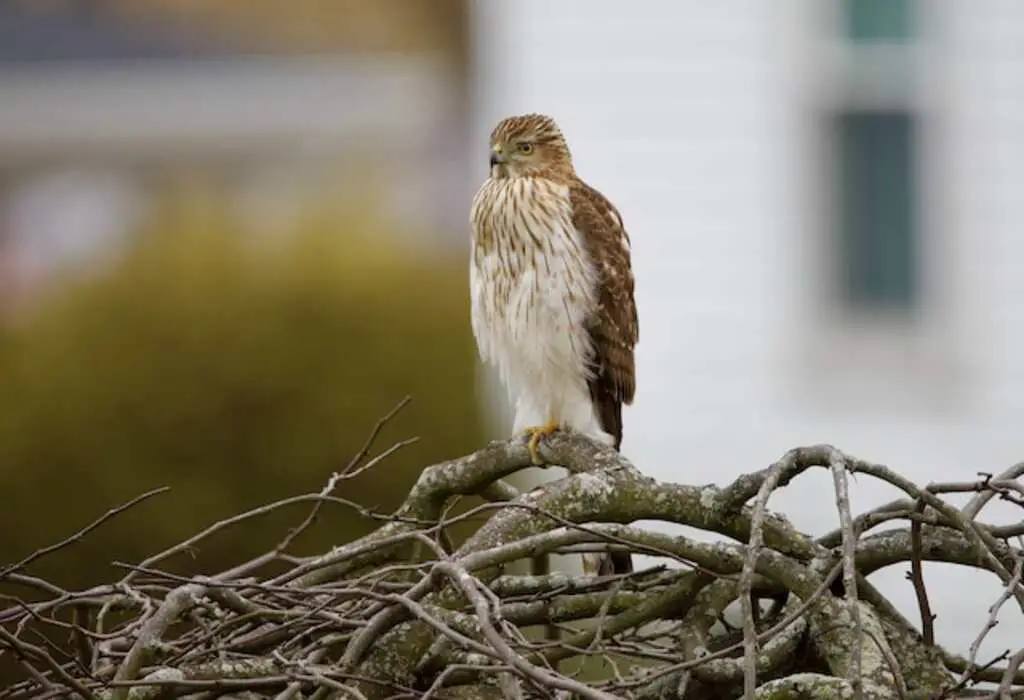Do Hawks Eat Lizards? The burning question that has puzzled nature enthusiasts and curious minds alike. Well, brace yourself for a wild ride as we unravel the truth behind this raptorial mystery.
From lizards who outsmart the sky’s mightiest hunters to surprising adaptations and fascinating hunting techniques, this article dives deep into the captivating relationship between hawks and lizards.
Prepare for jaw-dropping revelations and a few lizard-y tales that will leave you hungry for more! So, without further ado, let’s soar into the realms of hawkish appetites and uncover the secrets within.
Table of Contents
- 1 The Majestic Hunters of the Sky: Hawks
- 2 What are hawks?
- 3 What do hawks eat?
- 4 How does a hawk’s diet vary depending on the species and location?
- 5 How does hunting behavior influence the hawk’s diet?
- 6 Lizards as Prey for Hawks
- 7 How do Hawks hunt Lizards?
- 8 Conclusion
- 9 FAQS: Do Hawks Eat Lizards?
- 9.1 Can hawks really eat lizards?
- 9.2 What types of hawks eat lizards?
- 9.3 How do hawks catch lizards?
- 9.4 Are lizards a primary food source for hawks?
- 9.5 Do hawks eat all types of lizards?
- 9.6 Do hawks have any advantages in capturing lizards?
- 9.7 Are there any lizards that can escape hawk attacks?
- 9.8 How do hawks benefit from eating lizards?
- 9.9 Can hawks digest lizards easily?
- 9.10 Are there any other interesting facts about hawks and lizards?
- 10 Author
The Majestic Hunters of the Sky: Hawks
Hawks are one of the most fascinating birds of prey, with their sharp talons, hooked beaks, and incredible hunting skills.
These birds are highly adaptable and can be found in almost every corner of the world, from tropical rainforests to arctic tundras.
The diet of hawks is quite diverse and varies depending on their species, habitat, and hunting behavior.
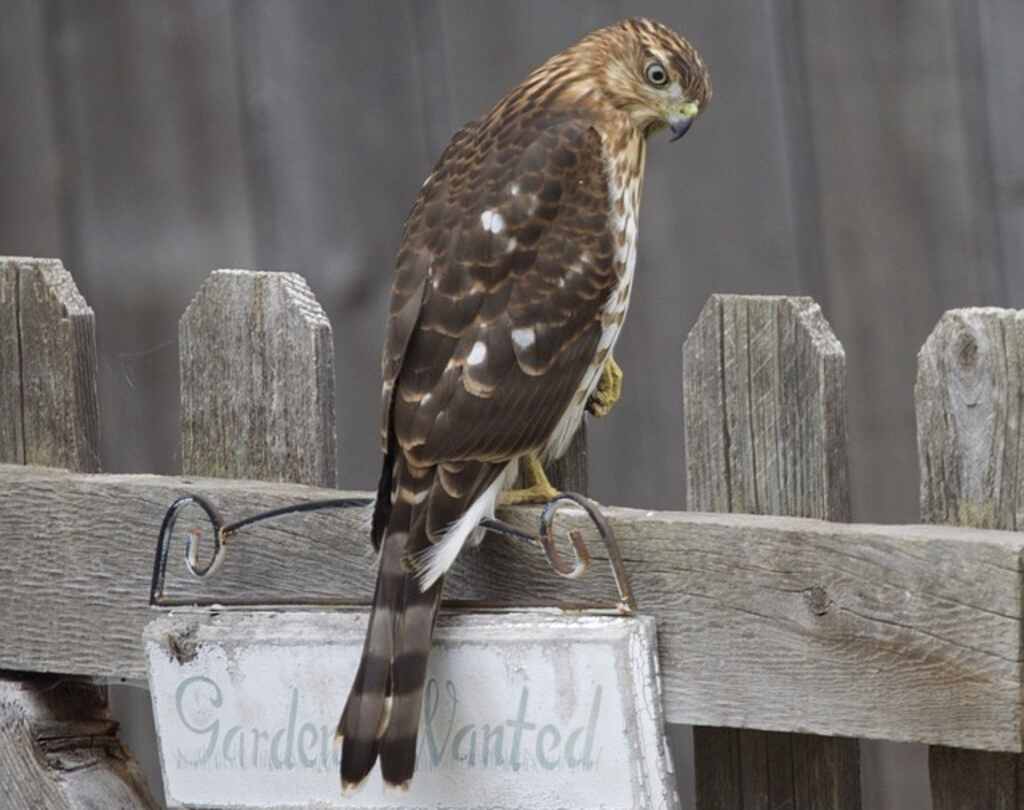
The Diet of Hawks: A Brief Overview
Hawks are carnivorous predators and feed on a variety of prey items. They mostly hunt small mammals like rodents, rabbits, squirrels, and even bats.
However, they also prey on smaller birds like finches or sparrows and reptiles like snakes or lizards.
In some cases, larger hawk species like red-tailed hawks may even take down larger prey like rabbits or hares. Understanding what hawks eat is essential to understanding their role in the ecosystem.
As apex predators at the top of the food chain, they help regulate populations of other animals by keeping them in check.
Moreover, they play a crucial role in maintaining the delicate balance between predator and prey relationships.
Why Understanding the Diet of Hawks is Important
Knowing what hawks eat is critical for several reasons. For one thing, it enables us to appreciate these remarkable creatures’ sophisticated hunting abilities fully. It allows us to understand how they interact with other animals in their environment better.
Furthermore, understanding what hawks eat can help us develop better conservation strategies for these magnificent birds. It helps us identify potential threats to their survival and take necessary measures to protect them.
The Question at Hand: Do Hawks Eat Lizards?
One common question many people ask about hawks is whether they eat lizards. The answer to this question is not as straightforward as you might think. While hawks do eat lizards, this is not a common prey for most species.
The main reason for this is that lizards are faster and more agile than most of the prey hawks typically hunt. In this article, we will explore the question of whether hawks eat lizards in greater detail.
We will delve into the different factors that influence hawk diet, which species of hawks are known to eat lizards, how they catch and consume them, and much more.
By the end of this article, you’ll have a comprehensive understanding of what role lizards play in a hawk’s diet.
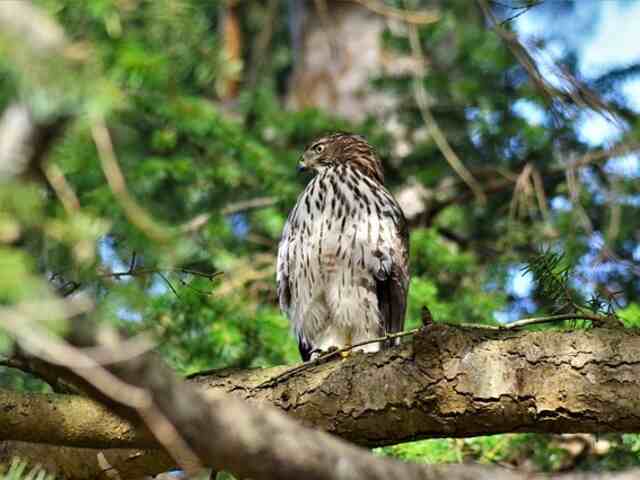
What are hawks?
Hawks are birds of prey that belong to the family Accipitridae. They are characterized by their sharp talons, hooked beaks, and keen eyesight, which make them formidable hunters in the avian world.
Hawks come in a variety of sizes and colors, with wingspans ranging from 18 inches to over 4 feet. They are found all over the world except for Antarctica and some remote islands.
There are many different species of hawks found in North America, each with their own unique characteristics and habitats.
Some common species include the Red-tailed Hawk, Cooper’s Hawk, Sharp-shinned Hawk, and Northern Harrier.
The Red-tailed Hawk is one of the most widely distributed hawks in North America and is known for its distinctive red tail feathers. The Cooper’s Hawk is a medium-sized hawk that has adapted well to urban environments.
Description of hawks and their physical characteristics
In terms of physical characteristics, hawks have powerful legs with sharp talons that they use to capture prey. Their hooked beaks are designed for tearing meat apart into pieces small enough to swallow whole.
Hawks also have excellent vision, with binocular vision allowing them to see greater detail than humans, as well as superior depth perception.
Hawks have strong wings designed for soaring or flapping while hunting or traveling long distances
Although these wings may look thin or fragile at first glance, they can withstand significant stress during flight because they contain strong muscles connecting them together within the bird’s chest cavity.
Overview of hawk species found in North America
There are several different types of hawks found throughout North America. These include, but not limited to:
1) Red-tailed Hawks – These birds are large raptors with broad wingspan averaging between 45–52 inches, they are adaptable and found in nearly all kinds of habitats such as forests, deserts, grasslands, agricultural fields etc.
2) Cooper’s Hawk – These birds are medium-sized raptors with a wingspan of around 24–36 inches. They are known to be quite stealthy hunters and often seen at backyard bird feeders looking for small birds like Sparrows or Doves.
3) Sharp-shinned Hawks – These birds are very similar to the Cooper’s Hawk, but have a smaller wingspan of around 20–25 inches. They mostly feed on small birds such as Songbirds or Thrushes.
Discussion on the hunting behavior of hawks
Hawks have several hunting strategies that they use to capture prey. Some hawks hunt from a distance by soaring high above their prey and then diving down at high speeds to catch it by surprise.
Others hunt from low perches and ambush their prey when it comes within striking distance. Some species even chase their prey on foot or pursue it through thick vegetation.
One technique commonly used by hawks is called “mantling.” This is when they spread their wings over their kill to protect it from other predators while they eat.
Hawks also have the ability to catch prey mid-air with their talons while flying, which is an impressive display of agility and skill.
Hawks are fascinating birds of prey that play an important role in maintaining balance in ecosystems throughout North America.
Their physical characteristics and hunting behaviors make them formidable predators that are always exciting to observe in the wild.
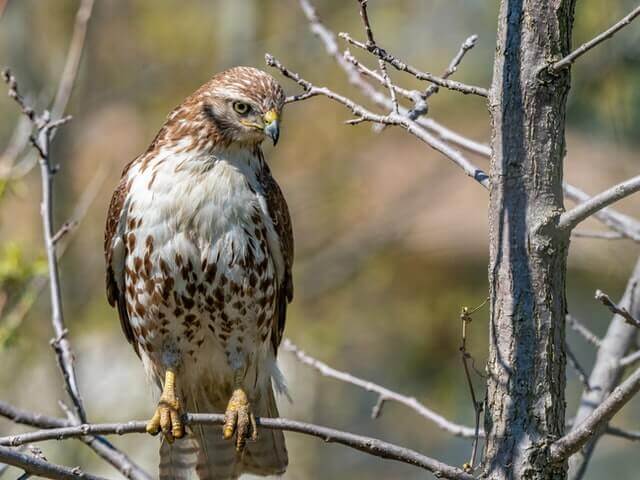
What do hawks eat?
Hawks are raptors, or birds of prey, and they have a varied diet that includes small mammals, birds, and reptiles. Depending on the species of hawk, their diet may also include insects, fish, and even other raptors.
Hawks are carnivorous and hunt for their food by using their excellent eyesight to spot potential prey from high in the sky. Hawks primarily feed on small mammals like rodents and rabbits.
The most common species of hawks in North America such as the red-tailed hawk prefer to hunt these types of animals as they offer a good balance between nutrients and energy expenditure during hunting.
Smaller bird species also make up a significant portion of the hawk’s diet.
Hawks typically capture birds mid-flight by using their powerful claws called talons. Reptiles such as snakes and lizards are also popular food sources for some hawk species.
Some examples include Cooper’s hawk and sharp-shinned hawk, who feed on small reptiles frequently.
However, not all hawks consume reptiles, since lizards may not provide enough nutrition for larger hawk species like eagles or vultures.
How does a hawk’s diet vary depending on the species and location?
The specific diet of a hawk can vary based on its location in terms of geographic factors like climate or habitat type along with availability of prey items within that area.
For example, hawks living near forests may have access to more small mammals for its diet compared to those residing near grasslands where smaller birds become more prevalent in the diet plan.
In addition to geographic factors influencing what hawks eat – different species may have varying diets due to adaptations developed over time or behaviors specific towards certain prey items.
For instance, Cooper’s Hawks find it easier to catch mid-sized birds while Red-tailed Hawks prefer hunting ground-dwelling animals such as rabbits, which they can easily spot from their perch.
Furthermore, migration habits of some hawk species also contribute to dietary variations. Hawks that migrate long distances may need to consume more food for energy.
During migration, hawks will typically feed on anything available until they reach their destination. Hence, the diet of a migrating hawk is likely to be more varied than that of a non-migrating one.
How does hunting behavior influence the hawk’s diet?
Hunting behaviors vary between different hawk species as well as individuals within a species. The hunting style and techniques used by hawks are largely dependent on both the size and agility of their prey animals.
For example, hawks with larger talons often rely on catching animals in flight, while those with smaller talons adapt better when hunting ground-dwelling prey like rabbits.
Hawks that hunt in groups or pairs exhibit different feeding behaviors than those who hunt alone.
Hawks working together tend to focus on larger prey items because they can tackle them more effectively with teamwork, while solitary hunters focus on smaller prey items which they can handle alone.
The type of habitat where hawks live also influences their hunting behavior, which in turn affects their diet plan.
Hawks living near forests often hunt at dawn or dusk when small mammals like rabbits and rodents become active, whereas those residing near grasslands may be active all day in pursuit of small birds.
A hawk’s diet depends on its location (habitat type and geographic factors), migratory behaviors, species-related adaptations such as talon size & shape – and the animal’s particular hunting style and techniques used to capture prey items successfully.

Lizards as Prey for Hawks
Hawks are opportunistic hunters and will prey on a variety of animals, including lizards. While not all hawk species eat lizards, some, like the Red-tailed hawk and Cooper’s hawk, are known to hunt them.
In this section, we will explore why lizards may be an attractive prey item for certain hawks and how hawks capture and eat them.
Overview of Lizard Species Found in North America
There are over 100 species of lizards found in North America, ranging in size from a few inches to several feet long. Some common lizard species that hawks may prey on include the collared lizard, the western fence lizard, and the whiptail lizard.
These species are often found in open areas with plenty of sunlight and rocky terrain. While there are many different types of lizards in North America, not all are suitable prey for hawks.
Some larger species may be too difficult to catch or too dangerous to attack due to their sharp claws or venomous bites. Additionally, smaller lizards may not provide enough sustenance for a hawk.
Why Lizards May Be an Attractive Prey Item for Certain Hawk Species
Lizards can be an attractive prey item for hawks because they are abundant in certain areas and relatively easy to catch compared to other prey items like rodents or birds.
Lizards also provide important nutrients like calcium that can be beneficial for a hawk’s health.
Certain hawk species may also have adaptations that make them well-suited for hunting lizards specifically.
For example, some birds of prey have sharp talons that allow them to grasp onto slippery reptile skin more easily than other animals’ fur or feathers.
Explanation on How a Hawk Captures and Eats a Lizard
When hunting for lizards, hawks will often scan open areas like meadows or rocky outcroppings from high up in the sky.
Once they spot a potential prey item, they will swoop down and use their sharp talons to grab onto the lizard’s body. Once a hawk has captured a lizard, it will often kill it by crushing its skull with its beak.
The hawk may then use its beak to tear off pieces of flesh and swallow them whole. If the lizard is too large to swallow whole, the hawk may use its sharp beak to tear it into smaller pieces.
Hawks are opportunistic hunters that will prey on a variety of animals including lizards. While not all species of hawks eat lizards, some are well-suited for hunting them specifically.
Lizards can provide important nutrients for hawks and can be relatively easy to catch compared to other prey items.
When hunting lizards, hawks will use their sharp talons and strong beaks to capture and kill their prey before consuming it in bite-sized pieces.

How do Hawks hunt Lizards?
Explanation on how Hawks spot their prey from above.
Hawks have excellent vision and can spot potential prey from high up in the sky. They have keen eyesight that allows them to see small animals, including lizards, from hundreds of feet away.
The hawk’s sharp eyesight comes in handy when hunting lizards because they are often camouflaged to blend in with their surroundings.
The hawk will fly over an area while searching for prey and will spot a lizard moving below. Once the hawk has spotted a potential meal, it swoops down quickly towards the ground while keeping its eyes locked on its target.
It uses its powerful wings to dive down at a tremendous speed towards the lizard before it can escape.
Discussion about the different techniques used by Hawks to catch Lizards.
Hawks use different techniques depending on the species of lizard they are hunting and where they are located geographically.
For example, some hawks like to swoop down from above and grab a lizard with their talons while flying at high speeds.
Other hawks like to wait patiently for their prey to come within reach before making a quick strike with their talons.
Another technique that hawks use when hunting lizards is known as stooping or diving.
This technique involves diving straight down towards the ground while using gravity as an aid to increase speed so that by the time they reach their target, they are going at extreme speed.
Description about how they use their talons
Once a hawk has successfully caught a lizard, it will use its talons—sharp claws located on each foot—to hold onto it tightly so that it cannot escape.
Hawks have specially adapted talons that allow them to grip onto prey firmly without slipping or losing grip even when flying at high speeds.
These talons are essential for hunting lizards as they provide a secure and strong grip that is necessary to hold onto the prey.
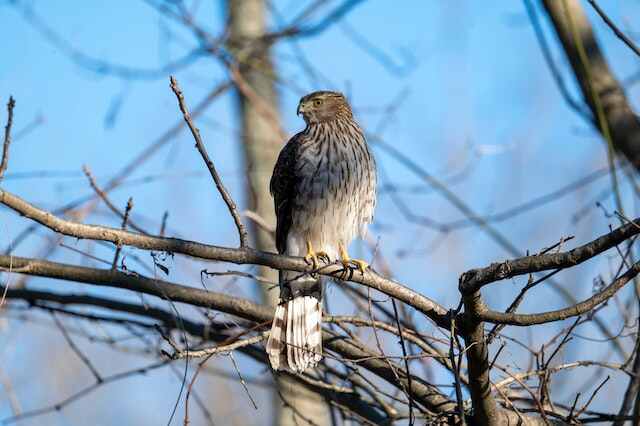
Conclusion
Hawks are skilled hunters that use their keen eyesight and powerful wings to spot, chase, and capture their prey.
Lizards are one of the many types of animals that hawks hunt, and different techniques are used depending on the species of hawk and lizard.
Hawks use their talons to hold onto the lizard tightly so that it cannot escape. Understanding how hawks hunt lizards can help us appreciate these magnificent birds of prey even more.
FAQS: Do Hawks Eat Lizards?
Can hawks really eat lizards?
Yes, hawks do eat lizards. These agile predators have a diverse diet, and lizards often make up a substantial portion of their meals. Hawks are known for their impressive hunting skills, and lizards provide a nutritious and energy-rich food source.
What types of hawks eat lizards?
Various hawk species indulge in the feast of lizards. Red-tailed hawks, Cooper’s hawks, and sharp-shinned hawks are just a few examples. Each species has its own unique hunting techniques and preferences, but they all share a taste for these scaly delicacies.
How do hawks catch lizards?
Hawks employ different strategies to catch lizards. They may soar high in the sky, scanning the ground for movement, or perch on trees and utility poles, waiting patiently for an opportunity to strike. Once spotted, hawks swoop down swiftly and use their sharp talons to snatch the unsuspecting lizards.
Are lizards a primary food source for hawks?
While lizards play a significant role in a hawk’s diet, they are not always the primary food source. Hawks are opportunistic hunters and adapt their diet based on availability. They also consume other small mammals, birds, insects, and even snakes.
Do hawks eat all types of lizards?
Hawks exhibit preferences for certain types of lizards, but they are known to consume a wide range of species. From small skinks to larger anoles and geckos, hawks have been observed feasting on various lizards that inhabit their hunting grounds.
Do hawks have any advantages in capturing lizards?
Hawks possess several advantages when it comes to capturing lizards. Their exceptional vision allows them to spot small movements from a great distance. Additionally, their powerful talons and sharp beaks give them the tools needed to seize and devour their slippery prey.
Are there any lizards that can escape hawk attacks?
Some lizards have evolved impressive escape strategies to avoid falling prey to hawks. Quick reflexes, camouflage abilities, and the ability to drop their tails as a distraction are a few tactics that certain lizards employ to increase their chances of survival against these formidable aerial predators.
How do hawks benefit from eating lizards?
Lizards provide hawks with essential nutrients and energy. As an integral part of their diet, lizards contribute to the overall health and survival of hawks. By consuming lizards, hawks fulfill their dietary requirements and maintain their predatory prowess.
Can hawks digest lizards easily?
Hawks have adaptations that aid in the digestion of lizards. Their digestive systems are designed to handle the bones, scales, and other components of their reptilian meals. The powerful stomach acids of hawks enable them to break down and extract nutrients from the lizards they consume.
Are there any other interesting facts about hawks and lizards?
Certainly! Hawks and lizards have a fascinating ecological relationship. For instance, hawks can influence the behavior and distribution of lizards in their environment. The presence of hawks may lead lizards to modify their foraging patterns or seek refuge in different habitats to avoid becoming a hawk’s next meal.

